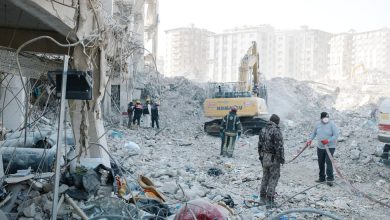Fires, Landslides, Lack of Snow: The Ski Industry Girds for Battle

From the top of an intermediate ski slope called Ridge Run at Lake Tahoe’s Heavenly resort, Bryan Hickman knew what was at stake.
It was late August and for the past two weeks the Caldor Fire had been tearing through California’s Eldorado National Forest. Nearly 150,000 acres of drought-primed timber, brush and grass had already burned and 72,000 more acres would go up in flames before the fire’s containment in October. Hundreds of homes in Grizzly Flats, a community of about 2,000 people, to the southwest, had been lost.
Climate change, a driving force behind catastrophic fires like this one, had placed one of the nation’s favorite winter destinations under siege.
Sierra at Tahoe, a 2,000-acre ski area, was already engulfed in flames, and chairlifts like Short Stuff and the trees around runs like Dogwood and Clipper were now charred. Embers wafted on the firestorm’s wind patterns to the mountains on the other side of Christmas Valley, where they ignited more fires that ran toward the ski shops, restaurants and homes of South Lake Tahoe and the Tahoe basin. Flames lashed a soot-colored sky as they approached resorts like Kirkwood to the south, and now Heavenly, which straddles the Nevada-California line.
“There was so much uncertainty,” Mr. Hickman recalled in an email. “It was really frightening.”
As a senior manager in charge of all snow surfaces at Heavenly, Mr. Hickman and scores of other employees began grueling 22-hour shifts to get 70 of the resort’s snowmaking guns slathering buildings, lifts and other critical infrastructure in water.The guns might not snuff a fire this angry, but the added humidity could buy firefighters some time.
An industry in peril
About 122 ski areas in the United States sit on national forest land — or about 60 percent of all downhill skiing capacity in the country — so fiery threats are nothing new to them. Two New Mexican resorts, Pajarito Mountain Ski Area and Ski Apache, suffered damage in separate wildfires about a decade ago. But the sport, along with ice fishing, pond hockey and scuba diving near a coral reef, could be something of an indicator species for the acute challenges climate change poses to the $788 billion outdoor industry and its legions of enthusiasts. With an estimated 15 million people going to Tahoe annually, the region and the thrashing it endured last summer serve as perhaps the starkest, most visible billboard yet of what lies ahead for ski areas caught in a crisis that knows no season.
“I always thought climate was going to take the industry out, for sure, but due to warming, shorter seasons and spring meltdown,” said Auden Schendler, Aspen Skiing Company’s senior vice president for sustainability. “I now believe the way we’re going down is through fire.”
Ski and outdoor industry leaders aren’t just standing by. While many areas have robust plans in case a fire hits, the country’s biggest ski companies, including Vail Resorts, Alterra, Powdr and Boyne, banded together to fight a changing climate that’s making those fire plans more relevant. Individual ski areas are also ramping up their own frontline efforts that now go well beyond LED lights and recycling. Still, how effective any of this might be remains to be seen.
“Until we get legislation on a federal level that tackles the problem, it’s really about adaptation and mitigation,” said Mike Reitzell, the president of Ski California, an industry group that represents 35 resorts in California and Nevada. “Fortunately, adapting is something we’re really good at.”
Exactly what’s in store for the ski industry has been studied at least 120 times in 27 countries so far, but the results largely paint the same picture, said Daniel Scott, a professor who researches climate and society at the University of Waterloo in Ontario. The average length of a ski season in the United States shrank for the first time in four decades during the 2010s, he said, and by 2050, New England can expect a season that’s 13 percent to 22 percent shorter than average. In Europe, the Chamonix-based Research Center for Alpine Ecosystems found spring is coming two to five days earlier each decade on Mont Blanc. In the American West, it’s dire. The amount of snow still covering the Rockies and Cascades in April — a major summertime water source for many — has shrunk on average 19 percent between 1955 and 2020, according to data compiled by the Environmental Protection Agency.
“We’re already thinking about our summer rafting business and what will happen if there’s less water in the rivers,” said John McLeod, president and general manager of Oregon’s Mount Bachelor, which also operates the Bend-based whitewater outfitter, Sun Country Tours.
And then there are the landslides, hurricanes, destructive winds and other weird, intense weather that ski areas must contend with. In August 2011, Tropical Storm Irene lashed Killington, Vt., with so much water that a flood dislodged the Superstar Pub from its foundation and caused it to collapse. In February, 2020, a landslide at Sasquatch Mountain Resort in British Columbia left hundreds of people stranded on the hill.
The economic impacts are staggering. A 2018 report by researchers at the University of New Hampshire and Colorado State University for the advocacy group Protect Our Winters shows the five least-snowy winters between 2001 and 2016 cost the industry an estimated $1 billion and more than 17,000 jobs a season. Mr. Scott, the climate professor, adds vacation property values could decline and ski areas that can’t make enough snow may close. In Colorado, workers have already extended snowmaking to the top of 11,212-foot-high Aspen Mountain so managers can run the top half of that resort independently in anticipation of losing lower elevation runs. The ski areas that do survive are likely to become more crowded even as the general skier population dwindles.
“Assuming demand remains near current levels, which the analogues of recent record warm winters have demonstrated,” said Mr. Scott, “resorts will have to accommodate more skiers in fewer ski days, with less terrain open.”
A two-prong approach
To fight this, ski areas are taking a two-prong approach, in Washington, D.C., and at home. The political fight to combat climate change is a slow-moving one, but groups like the National Ski Areas Association, the Outdoor Industry Association and Snowsports Industries America work with lawmakers — like Representative Ann McLane of New Hampshire who leads the Congressional Ski and Snowboard Caucus — to get them to enact meaningful climate policies. Protect Our Winters, a consortium of athletes, scientists, ski area managers and outdoor business leaders, wants a price on carbon, more renewable energy and cleaner transportation systems. To do that, the organization is trying to mobilize “the outdoor state” to “create a giant, powerful climate movement,” said Aspen’s Mr. Schendler, who is also the group’s chairman.
“The outdoor industry is bigger, wealthier, crazier and more influential than the N.R.A.,” he said. “We need CEOs and trade groups and leadership to wield that power ruthlessly. Pretend you are the N.R.A. and climate were gun rights. What would you do?”
For the past two decades, most of what’s been done has occurred at the local level as ski areas look to green their operations — a strategy that Mr. Schendler calls “fundamentally a PR move.”
Since 2000, however, the National Ski Areas Association has created guidance and initiatives to help ski areas become more sustainable and to do more advocacy work. Adrienne Saia Isaac, the organization’s director of marketing and communications, said American ski areas, working with the NSAA, have reduced their emissions by more than 110,000 metric tons over the past decade and they’ve purchased renewable energy credits for twice that amount. Together, that’s roughly the equivalent of not burning 352 million pounds of coal.
It’s also a pittance compared to the 400 to 1,600 billion metric tons of greenhouse gases that Oxford Net Zero, a research group at the University of Oxford in England, says we will need to remove from the atmosphere to ward off the worst of climate change, but it helps. Powering a resort almost entirely on solar energy as Park City and Deer Valley are doing; finding ways to build more eco-friendly housing, as a partnership between Utah’s Powder Mountain and Weber State University is doing; or even composting leftover food scraps more efficiently, as New Mexico’s Taos Ski Valley is doing — these moves may not move the needle much, but they still have value.
“If you were to take every ski resort in the country down to net zero emissions, we wouldn’t even put a dent in the problem, so we can’t do it alone,” Mr. Reitzell of Ski California said. “But when Palisades Tahoe works to eliminate single-use plastic, which isn’t going to make that big of a change, they also have thousands and thousands of people who see that, and so the hope is that these efforts grow far beyond the resort.”
Protecting glaciers and ‘farming snow’
Scientists estimate Switzerland could lose 90 percent of its remaining 1,500 glaciers by the end of the century, which has prompted some ski areas, like Engelberg, to cover its glaciers in summer with heat-reflecting textiles that slow the melting. That technique works, but it is very expensive, costing as much as $8.60 to save one cubic meter of ice, an April 2021 study published in the journal Cold Regions Science and Technology found.
Other experiments in the Alps involve misting glaciers to form protective layers of snow. At Canada’s Banff Sunshine Village, workers are finding better ways to “farm snow” by installing 82,000 feet of fencing to trap natural snowfall that they can then distribute around the resort instead of spending the energy to make snow.
Here in the United States, some resorts are adding wood chips to their slopes in summer or removing rocks so that they need less snow to make runs skiable come winter. More than 200 ski areas across the country have signed onto an NSAA initiative to reduce their environmental impact across 10 topic areas, including energy, supply chains and water. Some of the projects to emerge in recent years are “uber cool,” says Ms. Isaac, even if the return on the investment isn’t so robust.
Copper Mountain in Colorado, for instance, has volunteers collecting seeds from native wildflowers and grasses across the resort that they then use to restore disturbed areas. The plan could eventually include measuring the carbon this effort sequesters and packaging it as offsets. Alta, in Utah, has worked to restore wetlands and forests, while tree planting is a part of Powdr’s “Play Forever” commitment across its properties.
Aspen, meanwhile, spent about $5.34 million around 2012 retrofitting a nearby coal mine with a generator that creates about three megawatts of electricity using the mine’s methane gases that would otherwise be released into the atmosphere or burned uselessly in a flare. That power, which is sold back into the grid, is enough to power the resort annually.
Of course, little of this would do much to save a ski hill from a catastrophic wildfire, the rising threat of which has caused insurance premiums to triple in recent years for places like Mount Hood Meadows near Portland, Ore. That resort, along with Bogus Basin near Boise, Idaho, suffered near misses last season when fires started on their mountains. Both resorts had recently purchased new fire trucks and were able to attack the blazes right away.
“Our forests are much more dense than they were historically,” said Nadia Tase, a senior environmental scientist with the California Department of Forestry and Fire Protection. “One way to deal with it is to put more fire on the landscape, but we’re kind of now at this point where it is a challenge to do that safely at a large enough scale to make an impact.”
Oregon’s Mount Bachelor may have an answer.
The resort has completed the design on a wood-fired furnace facility near its West Village Base Area that would run off forest scraps created when workers thin a forest’s overgrown understory to prevent flames from climbing these “ladder fuels” into the tops of trees. The furnace is designed to burn chips made from this material to heat buildings, replacing about 150,000 gallons of propane the resort uses a year and reducing overall emissions by nearly a fifth.
Other ski areas like Bridger Bowl and Red Lodge in Montana, and Mount Abram in Maine, have similar projects underway.
In the end, California’s Caldor Fire did breach the Tahoe basin, and about 10,000 acres burned, an area more than three times the size of the largest fire ever recorded in the basin, 2007’s Angora fire. Firefighters stopped it from reaching Heavenly and South Lake Tahoe, and Kirkwood Mountain Resort escaped mostly unscathed, too.
Sierra at Tahoe didn’t fare so well, though. While early season snowstorms allowed some resorts in the region to open before Thanksgiving, Sierra’s managers in early December were still wrestling with the fire’s damage that complicates how and when the resort might open.
Meanwhile, even projects like Bachelor’s can’t atone for what some see as the biggest climate sin. “A lot of people still have to get in planes or in cars if they want to ski,” said Todd Walton, executive director of the Winter Wildlands Alliance. “The carbon impact from all of that far outweighs how you spin the lifts.”
Follow New York Times Travel on Instagram, Twitter and Facebook. And sign up for our weekly Travel Dispatch newsletter to receive expert tips on traveling smarter and inspiration for your next vacation.



